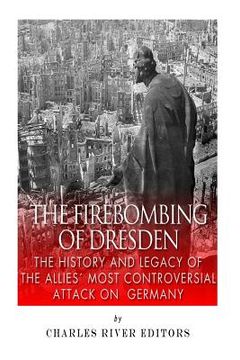The Firebombing of Dresden: The History and Legacy of the Allies' Most Controversial Attack on Germany (in English)
Synopsis "The Firebombing of Dresden: The History and Legacy of the Allies' Most Controversial Attack on Germany (in English)"
*Includes pictures *Includes survivors' accounts of the attacks *Discusses the various debates over the morality and necessity of targeting Dresden *Includes footnotes and a bibliography for further reading *Includes a table of contents "We saw terrible things: cremated adults shrunk to the size of small children, pieces of arms and legs, dead people, whole families burnt to death, burning people ran to and fro, burnt coaches filled with civilian refugees, dead rescuers and soldiers, many were calling and looking for their children and families, and fire everywhere, everywhere fire, and all the time the hot wind of the firestorm threw people back into the burning houses they were trying to escape from. I cannot forget these terrible details. I can never forget them." - Lothar Metzger, survivor In the middle of February 1945, the Allies were steadily advancing against the Germans from both east and west, with British and American forces having repulsed the German offensive during the Battle of the Bulge and the Soviet Union's Red Army pushing from the east. Indeed, the war would be over in just a little more than 2 months. Nonetheless, it was during this timeframe that the Allies conducted one of the most notorious attacks of the war: the targeting of Dresden. As a Royal Air Force memo put it before the attack, "Dresden, the seventh largest city in Germany and not much smaller than Manchester is also the largest unbombed builtup area the enemy has got. In the midst of winter with refugees pouring westward and troops to be rested, roofs are at a premium, not only to give shelter to workers, refugees, and troops alike, but to house the administrative services displaced from other areas. At one time well known for its china, Dresden has developed into an industrial city of first-class importance.... The intentions of the attack are to hit the enemy where he will feel it most, behind an already partially collapsed front... and incidentally to show the Russians when they arrive what Bomber Command can do." In the span of about 48 hours, Dresden was targeted by over 1,200 Allied bombers, which dropped nearly 4,000 tons of explosives on the town. The firestorms caused by this pounding hollowed out 1,600 acres and killed at least tens of thousands in gruesome ways. Ironically, many of the victims in Dresden had fled from the eastern front as the Soviets advanced, understandably worried about what kind of punishment the Soviets would dole out to captured Germans in response to the atrocities committed in Russia during the war. As the RAF memo noted, Dresden was relatively unscathed before the attacks, and the bombing was justified by the Allies based on Dresden being the home of hundreds of factories and a crucial railway. However, the widespread devastation immediately compelled the Nazis to use the attack as propaganda, and it has been condemned in the nearly 70 years since, with arguments still debating whether Dresden should've been attacked in the manner it was, and whether it was a disproportionate bombing. While most historians agree that the German war machine was in retreat by the time of this bombing of Germany's seventh largest city, other facts about the purpose and efficacy of the attack are less than decided. The debate over Dresden, which began shortly after the bombing and continues to this day, focuses not only on the necessity of the attack but also on the legitimacy of targets, and even on the disputed number of deaths that resulted. Though there was (perhaps) surprisingly little written about the Dresden attack during or immediately after the war, Chris Harmon, a military strategist and professor at the U.S. Naval War College, describes the Dresden attack as the "bloody shirt" that was waved often by those who questioned the morality of allied actions in retrospect. The Firebombing of Dresden analyzes one of the most controversial attacks of World War II

